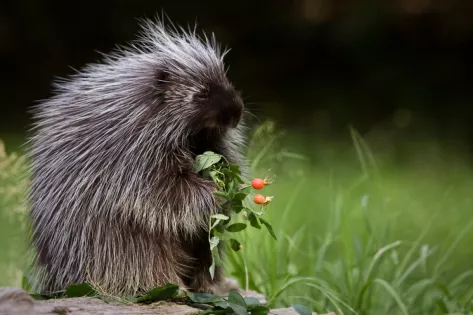
Curious about porcupines? Here are some top FAQs about these prickly cuties:
1. Do porcupines shoot their quills?
No, porcupines don’t shoot their quills like darts. They have loosely attached quills that detach easily when threatened. If an animal comes close or brushes against them, the quills will stick into the intruder, causing discomfort and irritation.
2. Are porcupines dangerous?
Porcupines are generally not aggressive and prefer to avoid confrontation. However, if they feel threatened, they will raise their quills and rattle them as a warning. It’s best to avoid getting close to them to prevent getting quilled.
3. What do porcupines eat?
Porcupines are herbivores and mainly eat bark, leaves, twigs, and fruit. Their strong teeth allow them to gnaw on tough plant material.
4. What are some interesting facts about porcupines?
- Porcupines have poor eyesight but excellent senses of smell and hearing.
- They can climb trees using their sharp claws and prehensile tails.
- Some species of porcupines can swim and even use their quills as floats.
- They groom each other with their teeth and claws to remove parasites and quills.
5. Are porcupines endangered?
The status of porcupines varies depending on the species. Some, like the North American porcupine, are widespread and not endangered. However, others, like the crested porcupine in Africa, are facing threats like habitat loss and hunting pressure.
6. How many species of porcupines are there?
The answer to how many species of porcupines there are depends on which classification system you follow. Here’s the breakdown:
Traditionally:
- Two families: Hystricidae (Old World porcupines) and Erethizontidae (New World porcupines)
- 11 species in the Hystricidae family
- 16 species in the Erethizontidae family
- Total: 27 species
Modern classification:
- One family: Hystricidae (encompassing all porcupines)
- 7 genera within the Hystricidae family
- 23 species total
The modern classification merges the two families based on recent genetic and morphological evidence. However, the traditional classification is still widely used, and the number of species can vary slightly depending on the source.
So, depending on the system you follow, the number of porcupine species is either 23 or 27.
7. Where do porcupines live?
The answer depends on which porcupine species you’re curious about! As mentioned previously, there are two main groups of porcupines, each with different distributions:
Old World Porcupines (Hystricidae):
- Found in Africa, Asia, and Italy.
- Live in a variety of habitats, including forests, deserts, grasslands, and rocky outcrops.
- Some species are strictly nocturnal, while others are active both day and night.
New World Porcupines (Erethizontidae):
- Found in North and South America.
- Primarily inhabit wooded areas, forests, and mountains.
- Some species are arboreal, spending much of their time in trees, while others are more terrestrial.
- Some species have a broader range, like the North American porcupine, while others are more confined to specific regions.
Here are some examples to illustrate the diversity:
- Crested porcupine (Hystrix cristata): Found in Africa, lives in savannas and woodlands.
- North American porcupine (Erethizon dorsatum): Found in Canada, the US, and northern Mexico, inhabits coniferous and mixed forests.
- Brazilian porcupine (Coendou prehensilis): Found in South America, lives in rainforests and other dense forests, known for its prehensile tail.
- Indian porcupine (Hystrix indica): Found in India, Pakistan, and Nepal, lives in forests, grasslands, and rocky outcrops.
Bonus FAQs:
- Do porcupines get hurt by their own quills? No, their skin is adapted to resist quills, but they can still become infected if they get embedded too deeply.
- How long do porcupines live? Their lifespan can range from 5-30 years, depending on the species.
- Do porcupines have predators? Yes, they are preyed upon by animals like owls, wolves, and snakes.














